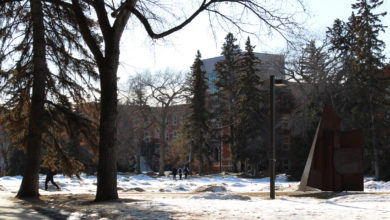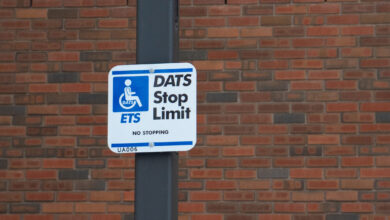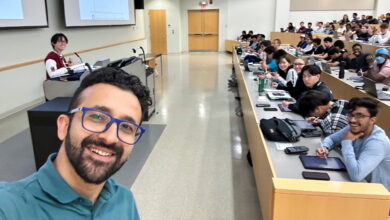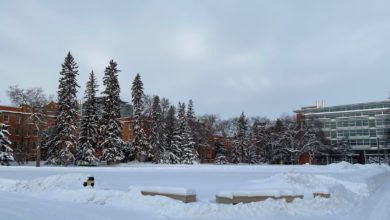U of A releases third-party review of encampment
"Police involvement and any actions that can lead to violence against our campus community should be an absolute last resort and not a quick decision,” UASU president says.
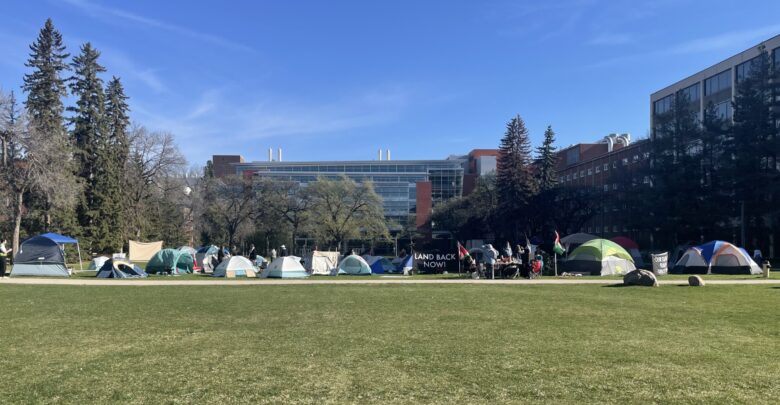 Lily Polenchuk
Lily PolenchukIn December 2024, the University of Alberta announced that the third-party review that was conducted regarding the removal of the May 2024 encampment was complete.
On May 9, 2024, the student-led group People’s University for Palestine (PU4P) YEG set up an encampment on the University of Alberta’s Main Quad, joining a wave of similar protests across North America.
In the early morning hours of May 11, the Edmonton Police Service (EPS) dismantled the site at the request of the university. Officers deployed non-lethal munitions and arrested three protestors. While EPS stated there were no serious injuries, demonstrators reported at least four, with one individual seeking emergency treatment. Videos of the dispersal circulated online, leading to criticism regarding EPS’ use of force.
In response, several student and staff associations, including the U of A Students’ Union (UASU), the Graduate Students’ Association (GSA), the Non-Academic Staff Association (NASA), and the Postdoctoral Fellows Association (PDFA), called for a third-party review “to assess the decisions, statements, and actions made by senior leadership officials that led up to the police being called to forcefully remove protesters.”
On July 2, 2024, the U of A Board of Governors (BoG) announced that it would proceed with a review. BoG selected retired Justice Adèle Kent, who served on the Court of King’s Bench of Alberta from 1994 to 2021, to lead the review.
On December 5, 2024, Kate Chisholm, chair of BoG, released a statement from the university announcing that the review was complete and that the final report was available to the public.
According to Chisholm, “Ms. Kent found that the university’s actions in response to the encampment were reasonable and lawful.”
U of A administrative communication was “subpar” during the encampment, according to UASU President
David Kahane, a professor in the department of political science at the U of A, disagrees with Kent’s conclusions. Kahane was present at the encampment when EPS arrived the morning of May 11.
“[Kent made] assumptions that are untrue and it undermines a lot of the key conclusions of her report,” Kahane said.
Kahane “[doesn’t] think that the third-party review was [the] right approach or has very much credibility.”
“[BoG] … chose the terms of reference and the reviewer for the third-party review. So it was always likely that the review would be ass-covering. That’s how I see it,” Kahane said.
Lisa Glock, UASU president, said that “the communication that [the UASU] received during the encampment process was subpar. It was not enough for us to act and to be involved and represent our students in the way that we would have liked to.”
“We also wish [for] the university to further engage with us on protest related procedures, better communication in any time of crisis, and addressing when, how, and where students are banned from campus,” Glock said.
Kent “seems quite credulous about some of the core claims,” Kahane says
Additionally, Kahane said that he does not believe that Kent was very informed of the protest’s cause.
“My impression of her is that she knew very little about the Palestinian cause [and] about the big political issues that gave rise to the encampment,” Kahane said.
“Given her naiveté and newness to the issues at stake, and given that she was talking to people like her, she seems quite credulous about some of the core claims,” Kahane added.
According to Kahane, the student leaders of the encampment refused to engage with the third-party review and Kent’s report because they thought that it was illegitimate.
“However, they did hold a [town hall] where testimonies were offered by people who were directly involved in the encampment. Kent refused to go to that,” Kahane said.
On May 12, 2024, President and Vice-Chancellor Bill Flanagan released a statement claiming that “only 25 [per cent] of the camp’s occupants were U of A students.” Kahane said that he does not think that this information is accurate or relevant to the situation.
“One question is why [does that matter]? Is it more legitimate to call in the police on students from other universities or alumni or members of the broader community?” Kahane said.
According to Kent’s report, the estimated numbers of U of A students was based on facial recognition analysis used by the University of Alberta Protective Services (UAPS).
“Where are they getting the archive of information about who is in the university community? Are they running our ONEcard photos and comparing them to facial recognition captures? Why is that reliable? Why is that legitimate? Did we give our permission for that?” Kahane said.
“We believe that police involvement was not the correct answer,” Glock says
According to Kahane, calling in EPS to remove the encampment put many people in danger and caused unnecessary violence. “The only injuries associated with the encampment were injuries at the hands of [EPS]. There were no other injuries,” Kahane said.
“There’s overwhelming evidence that for racialized people, for Indigenous people, for non-dominant group people, police are a source of danger. So Flanagan brought danger onto the campus by calling the police,” Kahane added.
According to Glock, the U of A should have exhausted other options “before the extreme steps of police intervention were taken.”
“We believe that police involvement was not the correct answer. Dialogue as well as negotiation could have been able to prove [better] results,” Glock said.
Flanagan “owes some apologies that he has never given for the encampment,” Kahane says
According to a statement from Flanagan published on May 12, 2024, “there can be no question that the encampment posed a serious and imminent risk of potential violence and injury to university community members and members of the public.”
In her report, Kent rejected Flanagan’s justifications for calling the EPS to assist with the removal of the encampment, Kahane said. Kent wrote that “the encampment remained peaceful,” on May 10, 2024. She further said that calling EPS on unauthorized land use was “entirely precautionary” and “there is nothing wrong in that approach.”
“She says there was no present danger. Flanagan, according to the third-party review, offered reasons for clearing the encampment that were untrue and unwarranted. So he owes some apologies that he has never given for the encampment,” Kahane said.
According to Glock, “the university needs consistent and equitable plans to engage with protests and communication on major issues.”
“A failure to plan was definitely a contributing factor to poor decision making and flawed harmful communications from senior administration that then led to this violent crackdown on a peaceful protest,” Glock said.
For Kahane, Kent’s review makes it “very clear that she is baffled that university administration never engaged with the encampment leadership.” He added that if the encampment was allowed to go on for longer, “it’s very likely that there would have been some better communication between university administration and the encampment leadership. If administration had been willing.”
In her report, Kent said that “there was a missed opportunity on May 9, 2024 to begin a dialogue or attempt to start to negotiate with the protesters to end the encampment.”
Glock called for improvement to university communication with students and the UASU.
“Involvement with the [UASU] and student representatives needs to be improved. Police involvement and any actions that can lead to violence against our campus community should be an absolute last resort and not a quick decision.”

